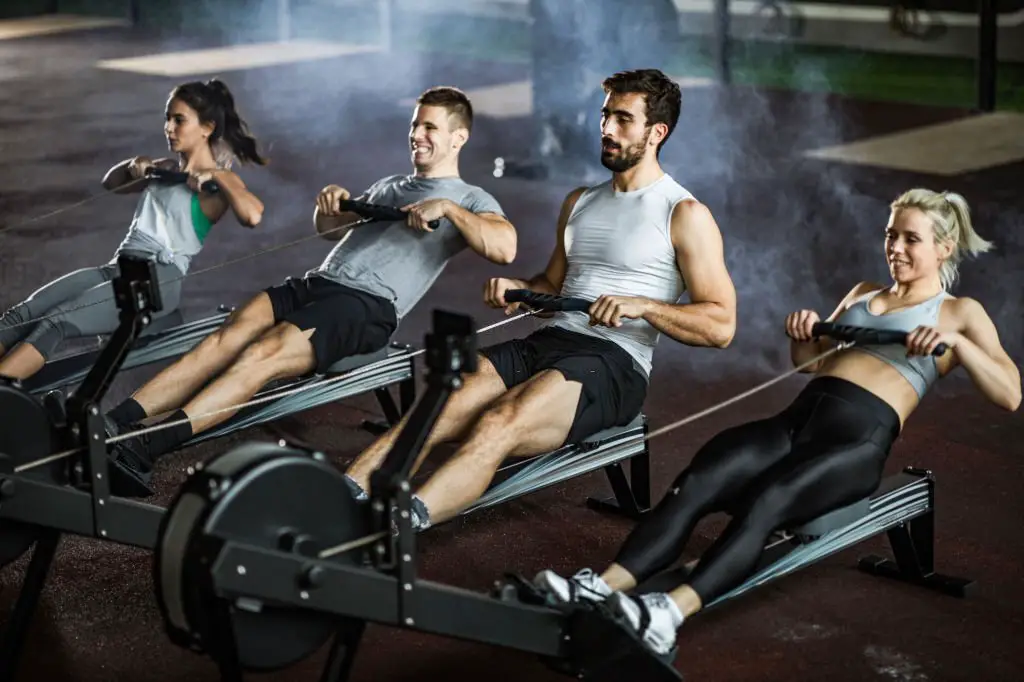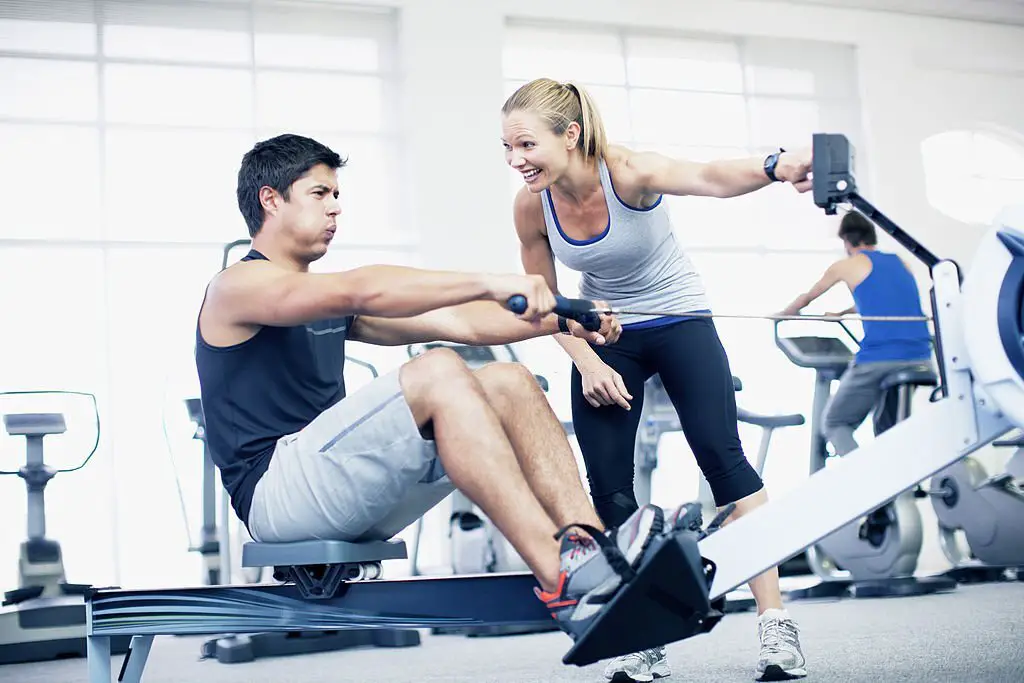Are you looking to add a rowing machine to your home gym but don’t know which type to choose? The debate between magnetic and water rowing machines is ongoing, so we’ve put together this guide outlining the pros and cons of each. In addition, we’ll provide some tips on how to get the most out of your rowing workouts regardless of which machine you end up choosing. Whether you’re an advanced athlete or just starting out, read on for everything you need to know about these popular fitness tools.
Table of Contents
Magnetic Rowing Machine vs. Water Rowing Machine: Pros and Cons
Magnetic rowing machines offer a smooth and quiet workout experience, making them great for home use. They also tend to be less expensive than water rowing machines and require less maintenance. On the downside, magnetic resistance may not provide the same level of resistance as actual water, which can limit the intensity of your workouts.
Magnetic rowing machines offer a quiet and affordable workout option, while water rowing machines mimic the feeling of real rowing on water for a more intense and enjoyable experience.
Water rowing machines simulate the feeling of actually rowing on water with their unique resistance system. This makes them great for building strength and endurance while also providing an enjoyable workout experience. However, they tend to be more expensive than magnetic rowers and require more maintenance due to their use of water in their mechanism.
Magnetic Rowing Machine
The magnetic rowing machine offers a smooth and quiet workout experience. With adjustable resistance levels, it is perfect for advanced users who want to challenge themselves and beginners who are just starting their fitness journey. Some other benefits of the magnetic rowing machines include:
- Wide range of resistance levels
- Reduced noise level during workouts
- Low maintenance requirements
To maintain your magnetic rowing machine, make sure to wipe down the seat rail and regularly check for loose bolts or connections. Overall, the magnetic rowing machine is a great investment that can provide an effective full-body workout without disturbing your surroundings with excessive noise.
Water Rowing Machine
When it comes to rowing machines, a water rowing machine is often considered the best option for those seeking a realistic feel. The sound of the water adds to the overall experience and can transport users to open waters. Though they tend to be pricier than other types of rowing machines, many enthusiasts consider them worth the cost for their quality and authenticity.
If you’re someone who values an authentic rowing experience above all else, investing in a water rowing machine may be worth considering. While they may require more financial commitment upfront, their realistic feel and soothing sound make them an attractive choice for advanced athletes or beginners looking to elevate their workouts.
Factors to Consider Before Choosing a Rowing Machine
Before choosing a rowing machine, consider the resistance type that will work best for you. Magnetic rowing machines provide adjustable resistance levels and are often less expensive than water rowers. On the other hand, water rowing machines offer a more realistic and smoother feel of rowing on actual water, but can be more expensive.
Another important factor to consider is the size and storage of the machine. If you have limited space in your home gym or apartment, it may be worth investing in a compact model that can easily fold up for storage. Additionally, noise level should also be taken into account if living in close proximity to others or with thin walls. Look for models with quiet operation to prevent disturbing neighbors or roommates during early morning workouts.
Resistance
Resistance is one of the most important factors to consider when choosing a rowing machine. Magnetic resistance machines are often more affordable and provide a smooth, consistent workout experience. Water resistance machines, on the other hand, offer a more realistic rowing feel and can be adjusted based on your own intensity level. Ultimately, it comes down to personal preference and fitness goals.
Resistance training is an effective way to build strength and improve cardiovascular health. Incorporating interval training into your rowing workouts can help you achieve these goals even faster. By alternating between high-intensity sprints and low-intensity recovery periods, you’ll challenge your body in new ways while burning calories and building endurance. Don’t be afraid to push yourself outside of your comfort zone – with consistency and dedication, you’ll see results in no time!
Price
Price is an important factor to consider when choosing between a magnetic or water rowing machine. Here are some key points to keep in mind:
- Magnetic rowers are generally cheaper than water rowers, with prices ranging from around $200 to $1000.
- Water rowers tend to be more expensive, with prices starting at around $700 and going up to $3000 or more.
- Keep in mind that the initial cost of the machine is not the only expenseyou may also need to consider ongoing maintenance costs for things like replacing batteries or lubricating moving parts.
Ultimately, it’s up to you whether you want to invest in a higher-end water rower or go for a more affordable magnetic model. Just make sure you choose something that fits within your budget and meets your specific needs as a user.
Size and Storage
When it comes to size and storage, both magnetic and water rowing machines have their own advantages. Magnetic rowers tend to be more compact, making them a great choice for those with limited space. They can easily be folded up and stored away when not in use. On the other hand, water rowers require more space due to their larger size but can also serve as an attractive piece of home decor.
When considering storage options, it’s important to keep in mind that while magnetic rowers may be easier to store, they often lack the same level of durability as water rowers. It’s crucial to choose a machine that fits your specific needs and living situation so you can maximize your workout experience without sacrificing convenience or longevity.
Noise Level
When it comes to noise level, the choice between a magnetic or water rowing machine can make a significant difference. Magnetic rowers operate quietly and are perfect for those living in shared spaces or with noise restrictions. On the other hand, water rowers produce a soothing sound similar to that of rowing on an actual body of water, which some people may find more enjoyable and motivating during their workout. Consider your surroundings and personal preferences before deciding on which type of machine best suits you.
It’s important to note that even though magnetic machines are generally quieter than water machines, they still produce some level of noise. To further reduce the volume during use, consider placing mats beneath the machine or using headphones while working out. Don’t let noise concerns discourage you from incorporating indoor rowing into your fitness routine – both magnetic and water machines offer effective workouts regardless of sound levels.
Benefits of Rowing Machine Workouts
Rowing machine workouts offer a plethora of benefits for people looking to improve their physical health. One major benefit is the improvement in cardiovascular health, as rowing engages all the major muscle groups and increases heart rate. This leads to improved blood circulation, increased lung capacity and better overall endurance.
Another benefit of regular rowing machine workouts is the development of muscular strength and endurance. Rowing targets muscles in your legs, core, back, shoulders and arms resulting in toned muscles with increased stamina over time. Moreover, it’s a low-impact exercise that reduces stress on joints while still providing an effective workout making it ideal for those recovering from injury or suffering from joint pain or arthritis.
Cardiovascular Health
An increased heart rate is one of the key benefits of using a rowing machine, which contributes to improved cardiovascular health. As you begin to work out, your heart pumps faster and more efficiently, strengthening your cardiac muscles and improving blood flow throughout the body. This leads to better oxygen supply for the working muscles and organs, increasing your endurance over time.
Improved blood circulation is another advantage of using a rowing machine regularly. As you engage in this low-impact exercise, blood vessels expand and contract repeatedly due to the rhythmic movement patterns involved in rowing. This helps increase nutrient supply to all parts of the body while removing waste products more effectively.
In addition to these benefits, regular use of a rowing machine can also help improve overall muscular strength and endurance as well as provide an excellent low-impact workout for those who are looking for an alternative form of cardio without putting excessive stress on their joints or bones.
Muscular Strength and Endurance
A full-body workout is crucial for developing both muscular strength and endurance. Engaging multiple muscle groups during your routine helps to enhance overall athletic performance, reduce the risk of injury and increase endurance. Targeted muscle group activation is also important for building overall strength, as it allows you to focus your efforts on specific areas that may be lagging behind or need more attention. By incorporating a combination of compound exercises and isolation movements into your routine, you can effectively stimulate all major muscle groups while promoting increased muscle mass growth.
Incorporating resistance training into your workout routine can be an effective way to build muscular strength and endurance over time. Increased muscle mass provides greater power output capabilities which translates into improved performance in various sports activities such as rowing machine exercise. A progressive overload approach should be taken when designing a weightlifting program by gradually increasing the amount of weight lifted over time which challenges muscles allowing them too adapt by becoming stronger overtime leading to improved cardiovascular health benefits gained from utilizing cardio equipment such as magnetic or water rowing machines will be enhanced through this type of comprehensive training regimen capable improving fitness levels beyond what would have been previously possible with only one type of fitness training activity alone.
Low-Impact Exercise
Low-impact exercises are becoming increasingly popular due to their numerous benefits. One of the advantages is that they put less pressure on joints and bones, making them suitable for individuals with joint problems or previous injuries. Low-impact workouts also have a reduced risk of injuries compared to high-impact ones as they involve slower movements and less jumping.
Moreover, low-impact exercises are perfect for all fitness levels, from beginners to advanced athletes. Whether you’re recovering from an injury or looking for a gentle workout routine, low-impact exercises such as yoga or Pilates can be customized to suit your individual needs without compromising effectiveness. Regardless of your fitness level, incorporating low-impact exercise into your routine can improve cardiovascular health and increase muscular strength and endurance over time while minimizing the risk of injury.
Tips for Getting the Most Out of Your Rowing Machine Workouts
To get the most out of your rowing machine workouts, it’s crucial to focus on proper technique. Start by sitting up tall with a straight back and engaging your core muscles. Make sure to drive through your legs first before pulling with your arms, and aim for a smooth, fluid motion throughout the stroke. Practicing good form may feel challenging at first, but it will ultimately help you avoid injury and build strength more effectively.
Progressive overload is another key element in maximizing the benefits of rowing machine workouts. Rather than simply repeating the same routine each time you hit the gym, gradually increase either intensity or duration over time to keep pushing yourself towards new goals. This might involve adding resistance or incorporating longer intervals into your workout – experiment until you find what works best for you!
Proper Technique
Maintaining proper technique is crucial when using a rowing machine. By following these guidelines, you will not only prevent injury but also maximize your workout:
- Maintain a straight back throughout the stroke
- Drive with your legs, then lean back slightly and pull the handle towards your chest
- Keep your arms extended during the recovery phase
Proper technique ensures that you are engaging all of the necessary muscle groups and getting the most out of each stroke. Remember to focus on quality over quantity, and adjust as needed to ensure that you are performing each movement correctly.
Progressive Overload
Increase resistance or duration gradually over several workouts to avoid injury. It is important to challenge yourself, but not at the expense of your safety. By slowly increasing the intensity of your workouts, you can prevent injuries and ensure steady progress.
Record your progress in a workout journal to track improvements and set new goals. Keeping track of your performance allows you to see how much you have improved over time and sets the foundation for setting realistic goals for future training sessions.
Incorporate different types of rowing workouts (steady-state, interval, etc.) for variety. Doing the same routine repeatedly can lead to boredom and stagnation in progress. Mix up your training by incorporating various rowing workouts that provide different challenges such as steady-state or interval training.
Remember, progressive overload is about making incremental changes towards improvement rather than drastic jumps that may cause harm or setbacks on our journey towards achieving our fitness goals!
Interval Training
Alternate between short bursts of high-intensity rowing and slower recovery periods to maximize the benefits of interval training. Experiment with different work-to-rest ratios (e.g. 1:1 or 2:1) to challenge yourself and keep your workouts interesting. By adjusting the intensity, you can boost your endurance, build strength, and burn calories more efficiently. Consider using heart rate monitors or other tracking tools to ensure proper intensity levels for optimal results.
Interval training is an effective way to improve your overall fitness on a rowing machine. It’s perfect for those who want a challenging workout that combines cardio and strength training in one session. With some creativity in designing your intervals, you’ll be able to target specific muscle groups while improving cardiovascular health at the same time. So give it a try today!



